
Virtual reality would make attending therapy easier for stroke survivors
25/11/2019
Researchers have created a virtual reality clinic to make it easier for stroke survivors to attend their physical and occupational therapy sessions. Results from a proof-of-concept study suggest that the technology - and the social connection it facilitates - are effective at encouraging therapy participation.
Skin-integrated VR device shows great potential for prostheses control
25/11/2019
A research team of scientists and engineers from City University of Hong Kong (CityU) and Northwestern University in the United States has developed a skin-integrated virtual reality (VR) system, which can be controlled and powered wirelessly. The innovation has great application potential in communications, prosthetic control and rehabilitation, as well as gaming and entertainment.
Immersion in virtual reality scenes of the Arctic helps to ease people's pain
20/11/2019
Watching immersive 360 videos of icy Arctic scenes helps to relieve intense burning pain and could hold hope for treating chronic pain, a small study has found.
ETH plans competence centre for holistic rehabilitation
20/11/2019
ETH researchers are planning to partner with clinics, foundations, public authorities and other institutions through a broad-based initiative aimed at improving the quality of life and participation of people with physical disabilities.
New 'bike helmet' style brain scanner used with children for first time
18/11/2019
A new wearable 'bike helmet' style brain scanner, that allows natural movement during scanning, has been used in a study with young children for the first time. This marks an important step towards improving our understanding of brain development in childhood.
Sleep and sleepiness 'a huge problem' for people with spinal cord injury
18/11/2019
A new study led by a University of Calgary researcher at the Cumming School of Medicine (CSM) finds that fatigue and sleep may need more attention in order to prevent issues like stroke after spinal cord injury.
A rail system allows child seat to be simply attached to the wheelchair
15/11/2019
Taking a child along in a wheelchair is not an easy task for people with walking disabilities. Within the framework of several student projects, young engineers at Technische Universität Kaiserslautern (TUK) have dealt with this topic.
Living in a noisy area increases the risk of suffering a more serious stroke
13/11/2019
The high levels of environmental noise we are subjected to in large cities can increase both the severity and consequences of an ischaemic stroke. More precisely, researchers put the increased risk at 30 percent for people living in noisier areas.
Quality over quantity! Interval walking training improves fitness and health
11/11/2019
Interval Walking Training is a method that is effective in increasing overall fitness and decreasing healthcare costs associated with lifestyle-related diseases of the middle-aged and elderly. That's the result of a study of Dr. Shizue Masuki of Shinshu University.
Researchers find high-intensity exercise improves memory in seniors
11/11/2019
Researchers at McMaster University who examine the impact of exercise on the brain have found that high-intensity workouts improve memory in older adults.
November 2019: Quo vadis inclusion?
07/11/2019
Ten years ago, the UN Convention on the Rights of Persons with Disabilities came into force in Germany. There is still considerable criticism of the current state of its implementation. The hope for a more inclusive society has not yet been fulfilled. But what about the rest of Europe? REHACARE.com has set out on a search – for positive developments, but also for obstacles still to be overcome.
It is not only in digital form that the diversity of people must be recognized and taken into account!
07/11/2019
Sweden is a pioneer in many things. But the Scandinavian country does not represent Europe. However, there is also no country that can be regarded as a positive overall example in the topic of Inclusion. Susanna Laurin from Funka knows why digital accessibility is a way to participate and why research in the field of disabilities and information and communication technology is so important.
High rates of dementia amongst people with Down syndrome
06/11/2019
Not so many years ago, people with Down syndrome rarely survived to middle age. Many died young due to heart problems associated with the congenital condition.Today, advances in treatment have allowed them to live longer, healthier lives. But these advances have also revealed a previously unknown characteristic of the condition: increased risk for dementia and Alzheimer's disease.
Predicting frailty, disability and death
06/11/2019
Using a wristwatch-like device, researchers detected fluctuations in the daily motor activity of older adults that could predict increased risk of deteriorated quality of life or death years later.
Looking at the way we walk can help predict cognitive decline
04/11/2019
The way people walk is an indicator of how much their brains, as well as their bodies, are aging. Scientists reporting say that gait disorders, particularly slowing gait, should be considered a marker of future cognitive decline. They propose testing motor performance as well as cognitive performance in older adults with mild cognitive impairments.
Risk factors for unemployment with multiple sclerosis vary by age
04/11/2019
A recent study by Kessler Foundation researchers explored numerous factors that contribute to the high unemployment rate among individuals of different ages with multiple sclerosis (MS). This is the first investigation to consider age within the context of disease- and person-specific factors affecting employment in MS.Tracking gaze patterns might help detecting autism
01/11/2019
Measuring children's gaze patterns as they watch movies of social interactions is a reliable way to accurately identify nearly half of autism spectrum disorder (ASD) cases, according to a new study just published in Autism Research by Ben-Gurion University of the Negev (BGU) researchers.
Rehabilitation: Exergaming with Icaros
30/10/2019
Studies show significant correlations between periods spent sitting and the prevalence of chronic diseases. This also applies to children and adolescents. One of the major obstacles to people taking up physical exercise is a lack of motivation. The solution could be Icaros: a flight simulator with exergaming technology that promises the user an element of fun while at the same time keeping fit.
Listening to 'noisy knees' to diagnose osteoarthritis
25/10/2019
A new way of diagnosing and assessing knee osteoarthritis (OA) has moved a step closer with a major study paving the way for its use in research and clinical practice. The technique involves attaching small microphones to knees, and detecting high frequency sounds from the joint components as people perform sitting standing movements.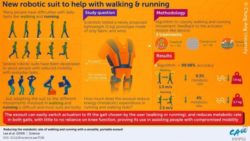
Lightweight, portable robotic suit to increase running and walking performance
23/10/2019
While walking may not seem like a burden for most people, for others, this simple task can often feel exhausting. For patients recovering from surgery or stroke, those with Parkinson's Disease, those with restricted mobility walking or running can be a struggle. Many researchers have pondered over this problem over the years, developing a number of external devices.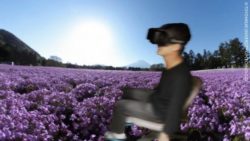
Virtual walking system for re-experiencing the journey of another person
23/10/2019
A research team in Japan has developed a virtual walking system with focusing on vision and foot vibrations, because these modalities seem critical and a minimal set to induce walking sensations. This system records a person walking, then re-plays it to another user through the oscillating optic flow and synchronous foot vibrations.
Deaf infants' gaze behavior more advanced than that of hearing infants
21/10/2019
Deaf infants who have been exposed to American Sign Language are better at following an adult's gaze than their hearing peers, supporting the idea that social-cognitive development is sensitive to different kinds of life experiences.
Dementia: Non-pharmacologic treatments more effective for psychiatric symptoms
18/10/2019
For patients with dementia who have symptoms of aggression and agitation, interventions such as outdoor activities, massage and touch therapy may be more effective treatments than medication in some cases, suggests a study published in Annals of Internal Medicine.
Heated suit simulates exercise benefits for people unable to take part in physical activity
16/10/2019
A team from Loughborough University is using the prototype device to help people with disabilities, elderly people, and those with chronic diseases that prevent them from taking part in exercise. It comes following a successful study into how hot baths can help reduce the risk of cardiovascular disease and type II diabetes.
Study questions 'cross-transfer' benefits of special exercise technique
16/10/2019
A paper recently published by researchers from the Ohio Musculoskeletal and Neurological Institute (OMNI) at the Heritage College of Osteopathic Medicine questions the effectiveness of a patented exercise system for relieving lower back pain.
Biologically-inspired artificial skin improves sensory ability of robots
14/10/2019
Sensitive synthetic skin enables robots to sense their own bodies and surroundings – a crucial capability if they are to be in close contact with people. Inspired by human skin, a team at the Technical University of Munich (TUM) has developed a system combining artificial skin with control algorithms and used it to create the first autonomous humanoid robot with full-body artificial skin.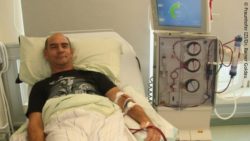
Affordable and mobile purification of dialysis water
14/10/2019
For patients who undergo dialysis, this artificial washing of the blood is a major burden. To remove toxins from the blood, large quantities of dialysis water for clearance are required. Until now there has been no solution so far to recover this dialysate cost-effectively. Therefore a cryo-purification method is being developed by Fraunhofer researchers that clears the water without loosing it.
October 2019: Research & development
01/10/2019
Basic research, technology development, and the development of a prototype to a marketable product - these are the steps that innovations go through before we can use them. REHACARE.de has looked around which promising tools could soon conquer the market for blind people and how a FabLab project tries to implement digital participation for all.
The basis for innovation: research and development
01/10/2019
Basic research, technology development, and the development of a prototype to a marketable product - these are the steps that innovations go through before we can use them. REHACARE.de has looked around which promising tools could soon conquer the market for blind people and how a FabLab project tries to implement digital participation for all.
Leveraging research and development to shape the future
01/10/2019
Whether it’s wheelchairs or prosthetics – there is an ongoing effort to continuously improve auxiliary aids and services. As a result, the standards of medical equipment also continue to change - always based on the latest developments and research results. That’s why REHACARE.com has taken a closer look at how trends like digitization and creative minds impact this industry sector.
Two innovative ideas expected to breathe new life into Braille
01/10/2019
Braille was invented nearly 195 years ago. The system has helped people to effectively participate at home and in society and acquire higher education ever since. It remains a reliable system that facilitates inclusion today. However, when it comes to Braille reader advancements, current technology is not nearly as up to date. Two projects plan to change that.
Daimler’s WheelPilot app finds accessible destinations
01/07/2019
Navigation systems are not a new invention. But what if an app for accessible destinations could be connected straight to your vehicle, thus making mobility easier for people with disabilities? The creative, innovative minds of Daimler AG’s Lab1886 challenged themselves to make it reality. That marked the birth of WheelPilot.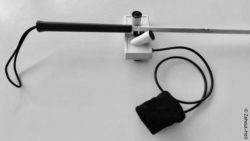
SmAccLab: Smart auxiliary means for everyone
28/05/2019
Accessible and realistic – that’s how auxiliary aids should be in the eyes of Professor Carsten Zahout. Students at the Smart Accessibility Laboratory (SmAccLab) are working on technical solutions that fulfill these requirements and lead to increased participation for people with disabilities. REHACARE.com found out how product engineering and inclusion join forces.
"ichó brings people with and without dementia together and provides a way to share stories, experiences, and impressions."
22/04/2018
Like the golden sphere in the fairy tale of the Frog King, ichó (Greek for echo) is meant to bring back lost motor skills and cognitive functions to people with dementia. The project of four former graduates of the Düsseldorf University of Applied Sciences aims to offer individual support through a person’s favorite music or fairy tale.
HelpCamps: "Making assistive technology faster, more affordable and personalized"
23/11/2017
In accordance with the slogan "Nothing about us without us", the HelpCamps project aims at developing and implementing concepts and ideas together. To make this a reality, people with disabilities, companies from the assistive technology, care and assistance sectors, as well as stakeholders in the so-called maker movement and researchers, are brought together to network during various events.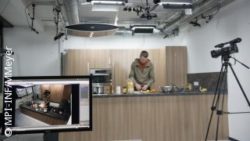
Will software automatically describe movie plots in the near future?
18/07/2016
In order to understand the plot of a movie an audio version is very helpful for visually impaired people. Authors watch the whole movies and describe what happens in each scene. But wouldn’t it be possible for a computer software to do this kind of work? Researchers work on developing a program which automatically generates movie descriptions and reads them out.